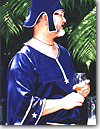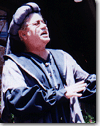
|
|
|
Medieval Mens Garment GalleryThe Medieval time period gives the men a wider variety of styles to choose from than with contemporary formal wear. Be he lord, knight or squire, reed thin or stout, a medieval outfit which compliments and enhances his figure can be found. You may wish to start your quest by perusing this Garment Gallery until you find some ensembles that are to your liking. Then you should assess your skill level (Lazybone, Novice, or Adept) and pick a design of the appropriate level of difficulty. With your design and measurements in hand proceed to the fabric store, for it is time for Choosing Fabrics and Picking Colors. You may also want to check out what kinds of Accessories you will need to complete your costume. Basic Garments for MenThe basic garments for this period consist of tunic, leggings, belt, and soft shoes. Stylistic embellishments can be added to these basic garments as desired. For a romantic look copy the French styles with frills and drapes or go for a sophisticated look with the English style of muted colors and clean lines. You may want to encorporate a little creative leeway time-period wise for the gentlemen who choose to attend in full Scottish regalia. Since medieval tunics and kilts don't really mix, I suggest that the kilted men wear Renaissance-style doublets. So, the kit for the Scottish male includes the doublet, shirt, kilt, belts, sporan, and boots. The tunic is the basic outer garment for men and the hallmark of the medieval period. It comes in an amazing variety and can be tailored to complement any man's figure. If you decide to go Scottish, instead of a tunic you would wear a poofy shirt, which is worn underneath the doublet. It is shorter than the tunic, not fitted and usually has long poofy sleeves. The neckline is high, with a slit down the center seam, and may be made with or without a collar. Leggings: Yes, the men must wear leggings, not pants. It's the combination of long tunic and tight leggings that makes these costumes look medieval. Cloth leggings, spandex tights, and opaque hose are all acceptable. Just choose what's most comfortable. Oh, and remember, if your tunic is short you'll want *very* opaque leggings. Special note for those of you who'll be wearing really long tunics - if nobody can see your legs you can cheat and wear pants. For any medieval costume you'll need at least one wide leather belt. For kilts you'll need several. Use the belt to cinch in the tunic at the man's waist. The tunic should poof out a little above the belt. It's a good idea to hang a cloth or leather pouch from the belt since the rest of the outfit doesn't have pockets. Plain soft leather shoes or low boots look best with medieval costumes. Soft-soled dancing shoes work really well. If you're going the kilt route you'll want to invest in a good pair of leather stompa boots. TunicsAs mentioned above, the tunic is the basic outer garment for men and the hallmark of the medieval period. It can be made in a variety of lengths and cuts, with sleeves or without, scooped neckline or square. The length of the tunic is determined by the social class of the wearer; the higher the rank, the lower the hem. If you want a fancy costume with rich fabrics and lots of trim then you'll want the tunic to be longer (maybe even floor-length!). Also, older gentlemen tend to wear their tunics longer. Depending on the wearer's preference, the tunic's sleaves can be just above or below the elbow, or all the way to the wrist. One variation eliminates the sleeves entirely (making it more of a tabbard), leaving the tunic open on the sides. The neckline can be a wide or short scoop or square, whichever looks good with the man's face. A six or eight inch slit down the front allows it to pull over the head. If you choose to adorn the tunic, go for a wide embroidered ribbon at the cuffs, around the neck and down the front slit. Don't worry about fitting the garment to the man's figure, the belt will take care of that. |
|
|
The Simple TabbardOkay, get ready to make the simplest garment in this entire web site! The tabbard is sort of a smock or apron for men. It's basically a big rectangle with a whole for the neck. A servant or page would wear a tabbard marked with their master's livery and a knight would wear one in his own family colors over his armor at tournaments. Go to the Pattern. |
 |
Wizard or Monk RobesSimilar to the Simple Tabbard only longer and with sleaves. This is the easiest to sew of the full mens garments, suitable for any skill level. Go to the Pattern. |
 |
MerchantFathers and uncles may desire a little more fabric than a tabbard affords, but may not want to go so far as the full wizard or nobles robes. The Merchant's coat is a perfect compromise. Go to the pattern. |
|
|
Crusading KnightFor the adventurous gentlemen, especially those who own their own swords, the look of the crusading knight can be quite dashing. Go to the pattern. |
|
|
Every Man Needs a Poofy ShirtOkay, so it's not technically Medieval... I firmly believe that every man should own a poofy shirt. Whether he's a Bryonesk poet or a rugged Highlander, all the girls will swoon when he saunters by in his poofy shirt. Go to the Pattern. Every Man Looks Good in a KiltBe advised that there's no historical evidence that kilts were worn in the middle ages... they're just cool and you can wear one if you want to! I firmly believe that kilts make men look more handsome and dashing than any other garment. (No matter awful his figure or personality is!) Every man should own at least one kilt. And we're not talking about those namby pamby modern kilts, I mean GREAT KILTS, the whole nine yard, fold those pleats by hand sheebang. Go to the Pattern. |
|
|